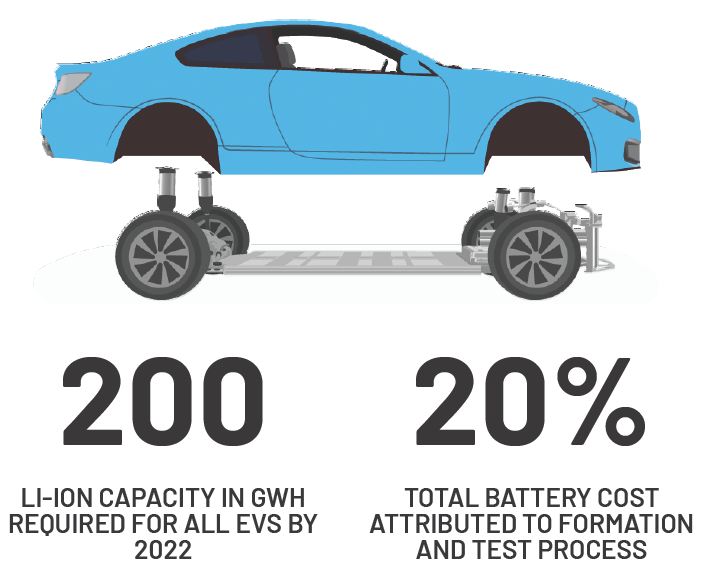
Take a look around on your next trip down Main St. and see for yourself the transformation taking place in the automobile industry: electric vehicle (EV) adoption has kicked into overdrive. In fact, up to 10% of all vehicles sold by 2025 are expected to be battery-powered, compared to less than 2% today1.
With this explosive growth in the EV market, naturally, the need for high performance batteries to power all these vehicles is also increasing. Beyond this, old EV batteries will eventually wear out and need replacing. Thus, the pressure is on to bring battery manufacturing equipment to market quickly. However, these companies cannot cut corners by using low performance equipment due to stringent battery requirements.
Analog Devices understands that EVs are only as good as the batteries that power them. It’s this understanding that has helped ADI become a leader in the critical battery formation and testing stage.
 AT A GLANCE
AT A GLANCE
COMPANIES/INDUSTRY
Electric vehicle manufacturers and battery formation and testing companies
APPLICATIONS
Battery Formation and Testing
CHALLENGES
The growth of the electric vehicle market is increasing demands on battery manufacturers and supply chains to deliver quality, reliable battery technology to keep up with the demand.
GOAL
Improve formation, quality, and reliability of batteries to enhance electric vehicle manufacturers’ performance and increase supply chain efficiency.
INVEST IN BATTERIES, POWER A BRAND
The high cost of producing EV batteries directly translates into the EV’s high sticker price. In fact, up to40% of an EV’s overall cost is due to the battery. In addition, the battery finishing stage (formation and testing) is particularly challenging, accounting for as much as 20% of the battery’s cost. But battery manufacturers fully understand the effect the end product can have on its overall brand. As history has shown in other markets (cellphones, power tools, gaming, etc.), a battery’s performance can be a major factor in determining a brand’s success.
Battery manufacturers and instrumentation providers realize that increasing the scale and efficiency of production is key to capitalizing on this burgeoning EV industry. But the issue lies not in cranking up battery production for the sake of getting to market first; rather, smart EV battery manufacturers realize that a battery’s performance quality must take precedence over all other factors.
After all, battery formation and test is a time-consuming process involving multiple charges and discharges that activate a battery’s chemistry. The process is painstaking and can take up to two full days to complete.But it’s necessary to help ready the battery for use and is critical to ensuring its reliability and quality.
STANDARD BEARER FOR PRECISION IN BATTERY FORMATION AND TEST
The level of precision in the formation and testing of a battery can fully determine its performance. The crucial battery formation and testing function ensures battery quality and safety, and ADI has contributed greatly to raising the bar in this field. ADI’s ongoing research has led to new products, reference designs, and integrated solutions that deliver high precision while enabling manufacturers to produce batteries more efficiently and fit more test capacity into a fixed factory footprint—all of which helps scale up battery formation and test, so customers can scale their EV production.
To decrease the cost of batteries, manufacturers need to take a holistic, “ecosystem-wide” approach and leverage system-level expertise to reduce the overall battery test circuit footprint while increasing the number of channels. It’s important to note that both must be done while maintaining the accuracy, precision, reliability, and speed of their battery formation and test measurements to ensure safety, performance, and reliability requirements are met.
This is not exactly an easy task to accomplish. For the front end, the power supplies driving the battery charging circuits need to be tightly controlled. Going deeper, battery formation and test requires close monitoring of current and voltage profiles used during power cycling to prevent overcharging and undercharging cells. This ensures safety during testing, while also maximizing battery longevity, which greatly lowers overall cost of ownership for the end user.
The benefits of working closely with ADI’s system-level expertise—along with having a broad portfolio of products—goes beyond having access to more sophisticated components and building blocks. It also gives battery manufacturers access to reference designs for system architectures that can be more easily adopted, making time-to-market three to four times faster than if a battery manufacturer were to develop a formation and test system from scratch.
What’s more, high precision at a system level during battery formation and testing (charging/ discharging a cell) enables power architectures that allow for energy recycling across multiple cells. Thus, manufacturers can create previously unobtainable efficiencies, expand throughput, and ultimately reduce waste/increase cost savings and make battery production more cost-effective.
With ADI taking the lead and steering the challenges of battery formation and testing into safer more efficient ground, manufacturers now have a partner with system-level experience—with an uncompromising commitment to precision—to help them meet the demand for high quality, high performance batteries for the burgeoning EV market.
The ADI Advantage for Battery Formation and Testing
- Technology performance that leverages the precision required to form batteries under repeatable conditions, ensuring consistent,high performance batteries.
- System-level expertise allows ADI to design solutions that increase the density and efficiency of the formation and grading
- System-level precision in battery formation enables manufacturers to leverage excess energy for additional cell formation.
- Integrated solutions reduce system size and allow battery manufacturers to fit more test equipment in the same space, allowing them to add formation and test capacity.

References :
1David Keohane and Peter Campbell. “Valeo Doubles Forecast for Electric Car Sales.” Financial Times, February 2018.
2electrive.com, “Number of Plug-In Cars Climbs to 5.6M Worldwide” (2019)

